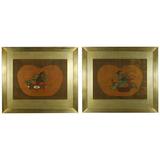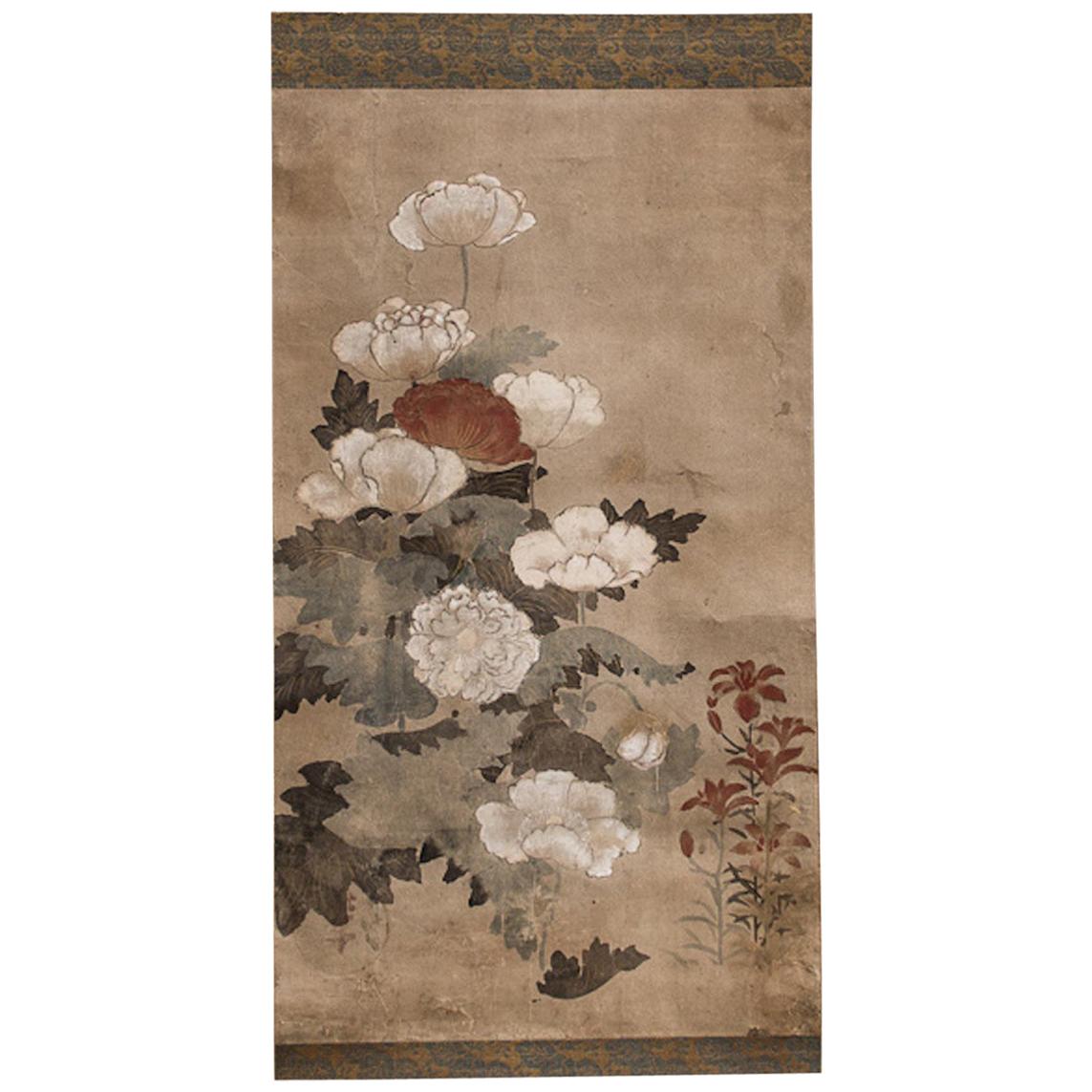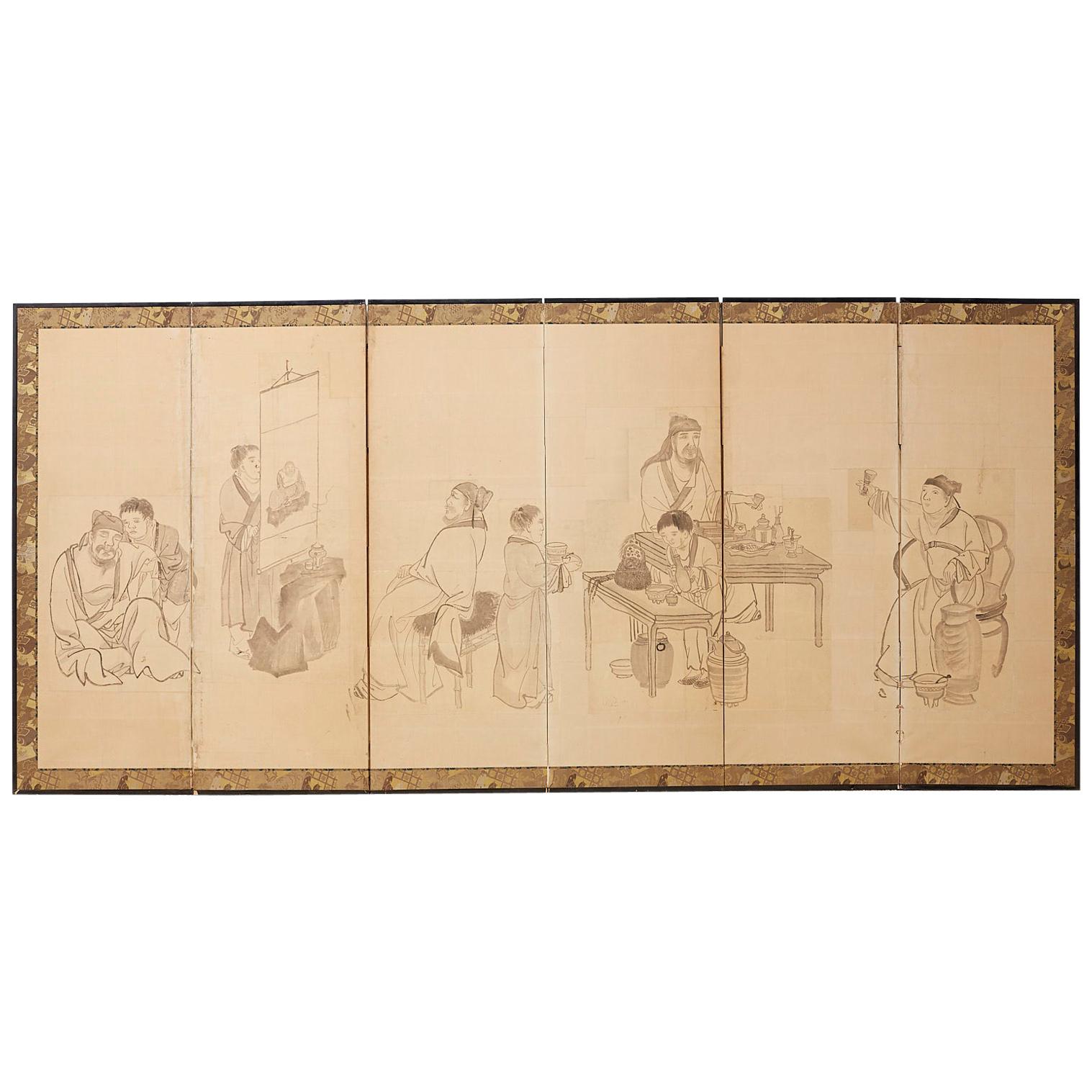Items Similar to Pair of Antique Japanese Paintings of Karashishi, Edo Period, 18th Century
Want more images or videos?
Request additional images or videos from the seller
1 of 10
Pair of Antique Japanese Paintings of Karashishi, Edo Period, 18th Century
About the Item
A rare pair of antique Japanese Karashishi paintings in a landscape of rocks and peony flowers on gold leaf ground in fine handmade frames, Edo period, early 18th century. The Karashishi (Chinese lion) and Komainu (Korean dog) are thought to have been introduced to Japan in around the 7th and 8th centuries AD. They are the lion-dog temple guardians of both Shinto shrines and Buddhist temples and have been placed at the entrances or in the eves of shrines and temples to ward off evil spirits since this time.
Materials: Ink, pigment and gold leaf on paper.
Dimensions (framed): H 198cm x W 121.5cm (each).
- Dimensions:Height: 77.96 in (198 cm)Width: 48.04 in (122 cm)Depth: 3.15 in (8 cm)
- Sold As:Set of 2
- Style:Edo (Of the Period)
- Materials and Techniques:
- Place of Origin:
- Period:
- Date of Manufacture:Unknown
- Condition:Wear consistent with age and use.
- Seller Location:Prahran, AU
- Reference Number:
About the Seller
5.0
Vetted Seller
These experienced sellers undergo a comprehensive evaluation by our team of in-house experts.
Established in 1979
1stDibs seller since 2015
76 sales on 1stDibs
- ShippingRetrieving quote...Ships From: Prahran, Australia
- Return PolicyThis item cannot be returned.
More From This SellerView All
- Pair of Antique Japanese Flower Paintings by Yanagisawa Kien, circa 18th CenturyBy Yanagisawa KienLocated in Prahran, VictoriaPair of antique Japanese Nagasaki School paintings by Yanagisawa Kien (1704-1758), depicting classical ikebana flower arrangements. Each painted on silk in mineral pigments and beari...Category
Antique Mid-18th Century Japanese Edo Paintings and Screens
MaterialsSilk
- 18th Century Japanese Kano School Landscape ScreenLocated in Prahran, VictoriaJapanese Kano school screen with pine tree, camellias, cherry blossom and Chinese figures in the landscape, circa 18th century. Materials: Pigmen...Category
Antique 18th Century Japanese Paintings and Screens
MaterialsSilver Leaf
- Japanese Bijin-ga Painting of Woman in Period Kimono, Taisho Period, circa 1920Located in Prahran, VictoriaRare Japanese Taisho period Bijin-ga style painting of a beautiful woman in period kimono holding a fan, circa 1920. Bijin-ga is a Japanese term used to describe paintings or pict...Category
Vintage 1920s Japanese Taisho Paintings and Screens
MaterialsSilk
- Large Antique Japanese Scroll Depicting a Nesting Crane, Taisho PeriodLocated in Prahran, VictoriaLarge and exceptional Japanese hanging scroll with a realistically painted depiction of a nesting crane by Yoshifuji Yoshio, Taisho/Showa perio...Category
Early 20th Century Japanese Taisho Paintings and Screens
MaterialsPaper, Silk
- 18th Century Japanese Painting of Red and White Peonies on a Gold Leaf GroundLocated in Prahran, VictoriaThis beautiful stylized depiction of red and white peonies once adorned a traditional four panel screen. Now it sits within its handmade frame, ready to grace your walls. The peony i...Category
Antique 18th Century Japanese Paintings and Screens
MaterialsGold Leaf
- Antique Japanese Kano School Painting by Yosenin KorenobuLocated in Prahran, VictoriaSix-panel Kano School tiger screen by Yosenin Korenobu (1753-1808). Sumi-e ink on paper, late 18th century. Dimensions: H 169cm x W 382cm.Category
Antique Late 18th Century Japanese Edo Paintings and Screens
MaterialsWood, Paper
You May Also Like
- Antique hanging scroll of Japanese cat/Late Edo-Meiji period/Cat paintingLocated in Sammu-shi, ChibaThis is a picture of a cat drawn by a person named "Toshizumi Nitta" from the end of the Edo period to the beginning of the Meiji period. She is a very simple and cute cat. He is a vassal of the Tokugawa Shogunate, born in Ota City, Gunma Prefecture (southern part of Gunma Prefecture). He was related to the Tokugawa family and lived in a large mansion in the Ota clan in Gunma prefecture. However, the Nitta family's territory was very small, and they were by no means a wealthy vassal. He seems to have lived quite poorly. So he painted cats and sold them to people. The Nitta family continued to draw pictures of this cat for four generations. "Nitta toshizumi" is equivalent to the fourth generation. During the Edo period, sericulture was thriving in the Kanto region. Cats were said to be the gods of silkworms, as they drive away mice, the natural enemies of silkworms. It was the Nitta family who drew such a cat on paper, pasted it in the silkworm chamber, and sold it as a mouse repellent. There were also other monks who painted pictures of cats, but the Nitta family in particular was related to the Tokugawa family, so people believed that paintings of cats had special powers. , a lot of paintings...Category
Antique Late 19th Century Japanese Edo Paintings
MaterialsPaper
- 18th Century Japanese Scroll of PoppiesLocated in Hudson, NY18th century Japanese scroll of poppies. Edo Period (early 18th century) Japanese painting of poppies with lilies in the background. Seal on the lower...Category
Antique Early 18th Century Japanese Edo Paintings and Screens
MaterialsSilk, Paper
- Japanese Six Panel Screen with Hotei, Edo Period, Early 19th CenturyLocated in Austin, TXA delightful Japanese six panel painted paper screen featuring the beloved figure Hotei, Edo Period, early 19th century. Hotei, called Budai in China, and known as the Laughing Buddha or Fat Buddha in the West, is considered to be an emanation of Maitreya, the Buddha of the Future. In Japan, he also holds a special place as one of the Seven Lucky Gods, being the god of fortune, and protector of children. He is always portrayed as a mirthful and corpulent man, dressed in loose robes that show off his round belly. He carries a sack with him, said to be filled with treasure. As the protector of children, he is often portrayed with them playing on or around him, as he is here. The children portrayed in this screen are dressed in Chinese style clothing...Category
Antique Early 19th Century Japanese Edo Paintings and Screens
MaterialsSilk, Paper
- Japanese Edo Period Six Panel Screen of Chinese ScholarsLocated in Rio Vista, CAFascinating 19th century Japanese late Edo period six pane funpon screen. Large scale depicting Chinese scholars and officials engaged in leis...Category
Antique 19th Century Japanese Edo Paintings and Screens
MaterialsWood, Paper, Silk
- Pair of Japanese Edo Period Six-Panel Screen, "100 Boys at Play"Located in Austin, TXAn absolutely charming pair of Japanese Tosa School six-panel folding screens painted with the "One Hundred Boys at Play" motif, featuring a multitude...Category
Antique Early 19th Century Japanese Edo Paintings and Screens
MaterialsGold Leaf
- Japanese Screen Pair, Tigers by Kishi Renzan, Late Edo PeriodLocated in Kyoto, JPKishi Renzan (1804-1859) Tigers Pair of six-panel Japanese screens. Ink and gold-leaf on paper. In this monochromatic pair of six-fold Japanese screens painted on gold-leaf, Kishi Renzan has created a breathtaking composition of a family of tigers. The screens are filled with a sense of drama which is conveyed by both the subject matter and the wet, expressive brushwork. The running mountain stream and the towering waterfall allude to refreshment during the summer months and we feel the tiger families familiarity and security within their environment. Renzan’s master, Kishi Ganku...Category
Antique Mid-19th Century Asian Edo Paintings and Screens
MaterialsGold Leaf
Recently Viewed
View AllMore Ways To Browse
Period 18th
Century Ad
Antique 18th Century Pairs
Edo Period Japan
Antique China Paintings
Pair Antique Painting
Pair Of Antique Paintings
Japanese Painting Antique
Chinese Lions
Gold Leaf Painting Japan
Japanese Painting Gold Leaf
Antique Japan Art Paintings
Pair 18th Century Painting
Pair Of Paintings 18th Century
Buddhist Temple
Japanese Painting On Gold Leaf
18th Century Flower Paintings
Painting Pair Flowers





